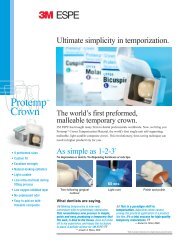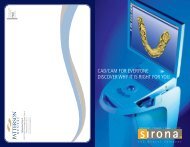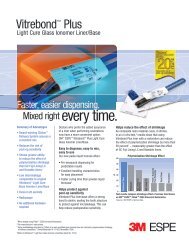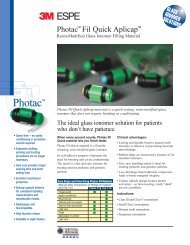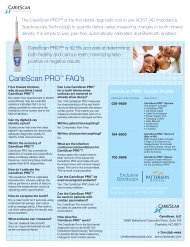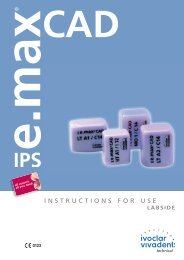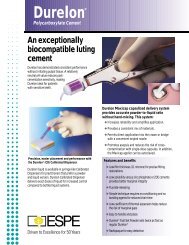Peridex/Periomed Brochure - 3M
Peridex/Periomed Brochure - 3M
Peridex/Periomed Brochure - 3M
Create successful ePaper yourself
Turn your PDF publications into a flip-book with our unique Google optimized e-Paper software.
<strong>Peridex</strong> Chlorhexidine Gluconate 0.12% Oral Rinse<br />
INDICATION: <strong>Peridex</strong> oral rinse is indicated for use between dental visits as part of a professional<br />
program for the treatment of gingivitis as characterized by redness and swelling of the gingivae,<br />
including gingival bleeding upon probing. <strong>Peridex</strong> oral rinse has not been tested among patients with<br />
acute necrotizing ulcerative gingivitis (ANUG). For patients having coexisting gingivitis and periodontitis,<br />
see PRECAUTIONS.<br />
DESCRIPTION: <strong>Peridex</strong> Chlorhexidine Gluconate 0.12% is an oral rinse containing 0.12% chlorhexidine<br />
gluconate (1, 11-hexamethylene bis [5-(p-chlorophenyl) biguanide] di-D-gluconate) in a base<br />
containing water, 11.6% alcohol, glycerin, PEG-40 sorbitan diisostearate, flavor, sodium saccharin,<br />
and FD&C Blue No. 1. <strong>Peridex</strong> oral rinse is a near-neutral solution (pH range 5-7). Chlorhexidine<br />
gluconate is a salt of chlorhexidine and gluconic acid. Its chemical structure is:<br />
CLINICAL PHARMACOLOGY: <strong>Peridex</strong> Chlorhexidine Gluconate 0.12% Oral Rinse provides<br />
antimicrobial activity during oral rinsing. The clinical significance of <strong>Peridex</strong> oral rinse’s antimicrobial<br />
activities is not clear. Microbiological sampling of plaque has shown a general reduction of counts<br />
of certain assayed bacteria, both aerobic and anaerobic, ranging from 54-97% through six months<br />
use. Use of <strong>Peridex</strong> oral rinse in a six month clinical study did not result in any significant changes in<br />
bacteria resistance, overgrowth of potentially opportunistic organisms or other adverse changes in the<br />
oral microbial ecosystem. Three months after <strong>Peridex</strong> oral rinse use was discontinued, the number of<br />
bacteria in plaque had returned to baseline levels and resistance of plaque bacteria to chlorhexidine<br />
gluconate was equal to that at baseline.<br />
PHARMACOKINETICS: Pharmacokinetic studies with <strong>Peridex</strong> oral rinse indicate approximately<br />
30% of the active ingredient, chlorhexidine gluconate, is retained in the oral cavity following rinsing.<br />
This retained drug is slowly released into the oral fluids. Studies conducted on human subjects and<br />
animals demonstrate chlorhexidine gluconate is poorly absorbed from the gastrointestinal tract. The<br />
mean plasma level of chlorhexidine gluconate reached a peak of 0.206μg/g in humans 30 minutes<br />
after they ingested a 300mg dose of the drug. Detectable levels of chlorhexidine gluconate were not<br />
present in the plasma of these subjects 12 hours after the compound was administered. Excretion of<br />
chlorhexidine gluconate occurred primarily through the feces (~90%). Less than 1% of the chlorhexidine<br />
gluconate ingested by these subjects was excreted in the urine.<br />
CONTRAINDICATIONS: <strong>Peridex</strong> oral rinse should not be used by persons who are known to be<br />
hypersensitive to chlorhexidine gluconate or other formula ingredients.<br />
WARNINGS: The effect of <strong>Peridex</strong> oral rinse on periodontitis has not been determined. An increase in<br />
supragingival calculus was noted in clinical testing in <strong>Peridex</strong> oral rinse users compared with control<br />
users. It is not known if <strong>Peridex</strong> oral rinse use results in an increase in subgingival calculus. Calculus<br />
deposits should be removed by a dental prophylaxis at intervals not greater than six months. Hypersensitivity<br />
and generalized allergic reactions have occurred. SEE CONTRAINDICATIONS.<br />
PRECAUTIONS:<br />
GENERAL:<br />
1. For patients having coexisting gingivitis and periodontitis, the presence or absence of gingival<br />
inflammation following treatment with <strong>Peridex</strong> oral rinse should not be used as a major indicator of<br />
underlying periodontitis.<br />
2. <strong>Peridex</strong> oral rinse can cause staining of oral surfaces, such as tooth surfaces, restorations, and the<br />
dorsum of the tongue. Not all patients will experience a visually significant increase in toothstaining.<br />
In clinical testing, 56% of <strong>Peridex</strong> oral rinse users exhibited a measurable increase in facial anterior<br />
stain, compared to 35% of control users after six months; 15% of <strong>Peridex</strong> oral rinse users developed<br />
what was judged to be heavy stain, compared to 1% of control users after six months. Stain will be<br />
more pronounced in patients who have heavier accumulations of unremoved plaque. Stain resulting<br />
from use of <strong>Peridex</strong> oral rinse does not adversely affect health of the gingivae or other oral tissues.<br />
Stain can be removed from most tooth surfaces by conventional professional prophylactic techniques.<br />
Additional time may be required to complete the prophylaxis. Discretion should be used when<br />
prescribing to patients with anterior facial restorations with rough surfaces or margins. If natural stain<br />
cannot be removed from these surfaces by a dental prophylaxis, patients should be excluded from<br />
<strong>Peridex</strong> oral rinse treatment if permanent discoloration is unacceptable. Stain in these areas may be<br />
difficult to remove by dental prohylaxis and on rare occasions may necessitate replacement of these<br />
restorations.<br />
3. Some patients may experience an alteration in taste perception while undergoing treatment with<br />
<strong>Peridex</strong> oral rinse. Rare instances of permanent taste alteration following <strong>Peridex</strong> oral rinse use have<br />
been reported via post-marketing product surveillance.<br />
PREGNANCY: TERATOGENIC EFFECTS Pregnancy Category B. Reproduction studies have been performed<br />
in rats and rabbits at chlorhexidine gluconate doses up to 300mg/kg/day and 40mg/kg/day,<br />
respectively, and have not revealed evidence of harm to fetus. However, adequate and well-controlled<br />
studies in pregnant women have not been done. Because animal reproduction studies are not always<br />
predictive of human response, this drug should be used during pregnancy only if clearly needed.<br />
NURSING MOTHERS: It is not known whether this drug is excreted in human milk. Because<br />
many drugs are excreted in human milk, caution should be exercised when <strong>Peridex</strong> oral rinse is<br />
administered to nursing women. In parturition and lactation studies with rats, no evidence of impaired<br />
parturition or of toxic effects to suckling pups was observed when chlorhexidine gluconate was<br />
administered to dams at doses that were over 100 times greater than that which would result from a<br />
person’s ingesting 30ml (2 capfuls) of <strong>Peridex</strong> oral rinse per day.<br />
PEDIATRIC USE: Clinical effectiveness and safety of <strong>Peridex</strong> Chlorhexidine Gluconate 0.12% Oral<br />
Rinse have not been established in children under the age of 18.<br />
CARCINOGENESIS, MUTAGENESIS, AND IMPAIRMENT OF FERTILITY: In a drinking water study<br />
in rats, carcinogenic effects were not observed at doses up to 38mg/kg/day. Mutagenic effects were<br />
not observed in two mammalian in vivo mutagenesis studies with chlorhexidine gluconate. The highest<br />
doses of chlorhexidine used in a mouse dominant-lethal assay and a hamster cytogenetics test<br />
were 1000mg/kg/day and 250mg/kg/day, respectively. No evidence of impaired fertility was observed<br />
in rats at doses up to 100mg/kg/day.<br />
ADVERSE REACTIONS: The most common side effects associated with chlorhexidine gluconate<br />
oral rinses are: 1) an increase in staining of teeth and other oral surfaces; 2) an increase in calculus<br />
formation; and 3) an alteration in taste perception, see WARNINGS and PRECAUTIONS. Oral irritation<br />
and local allergy-type symptoms have been spontaneously reported as side effects associated with<br />
use of chlorhexidine gluconate rinse. The following oral mucosal side effects were reported during<br />
placebo-controlled adult clinical trials: aphthous ulcer, grossly obvious gingivitis, trauma, ulceration,<br />
erythema, desquamation, coated tongue, keratinization, geographic tongue, mucocele, and short<br />
frenum. Each occurred at a frequency of less than 1.0%. Among post marketing reports, the most<br />
frequently reported oral mucosal symptoms associated with <strong>Peridex</strong> oral rinse are stomatitis,<br />
gingivitis, glossitis, ulcer, dry mouth, hypesthesia, glossal edema, and paresthesia. Minor irritation and<br />
superficial desquamation of the oral mucosa have been noted in patients using <strong>Peridex</strong> oral rinse.<br />
There have been cases of parotid gland swelling and inflammation of the salivary glands (sialadenitis)<br />
reported in patients using <strong>Peridex</strong> oral rinse.<br />
OVERDOSAGE: Ingestion of 1 or 2 ounces of <strong>Peridex</strong> oral rinse by a small child (~10 kg body weight)<br />
might result in gastric distress, including nausea, or signs of alcohol intoxication. Medical attention<br />
should be sought if more than 4 ounces of <strong>Peridex</strong> oral rinse is ingested by a small child or if signs of<br />
alcohol intoxication develop.<br />
DOSAGE AND ADMINISTRATION: <strong>Peridex</strong> oral rinse therapy should be initiated directly following<br />
a dental prophylaxis. Patients using <strong>Peridex</strong> oral rinse should be reevaluated and given a thorough<br />
prophylaxis at intervals no longer than six months. Recommended use is twice daily oral rinsing for 30<br />
seconds, morning and evening after toothbrushing. Usual dosage is 15ml (marked in cap) of undiluted<br />
<strong>Peridex</strong> oral rinse. Patients should be instructed to not rinse with water or other mouthwashes, brush<br />
teeth or eat immediately after using <strong>Peridex</strong> oral rinse. <strong>Peridex</strong> oral rinse is not intended for ingestion<br />
and should be expectorated after rinsing.<br />
HOW SUPPLIED: <strong>Peridex</strong> oral rinse is supplied as a blue liquid in:<br />
<br />
<br />
<br />
DIRECTIONS FOR USE: Fill cap to the “fill line” (15ml). Swish in mouth undiluted for 30 seconds,<br />
then spit out. Use after breakfast and before bedtime. Or, use as prescribed. NOTE: To minimize<br />
medicinal taste, do not rinse with water immediately after use.<br />
WHAT TO EXPECT WHEN USING PERIDEX ORAL RINSE:<br />
Your dentist has prescribed <strong>Peridex</strong> Chlorhexidine Gluconate 0.12% Oral Rinse to treat your gingivitis,<br />
to help reduce the redness and swelling of your gums, and also to help you control any gum<br />
bleeding. Use <strong>Peridex</strong> oral rinse regularly, as directed by your dentist, in addition to daily brushing.<br />
Spit out after use. <strong>Peridex</strong> oral rinse should not be swallowed.<br />
<strong>Peridex</strong> oral rinse may cause some tooth discoloration or increase in tartar (calculus) formation,<br />
particularly in areas where stain and tartar usually form. It is important to see your dentist for<br />
removal of any stain or tartar at least every six months or more frequently if your dentist advises.<br />
oth stain and tartar can be removed by your dentist or hygienist. <strong>Peridex</strong> oral rinse may cause<br />
permanent discoloration of some front-tooth fillings.<br />
o minimize discoloration, you should brush and floss daily, emphasizing areas which begin to<br />
discolor.<br />
ocal hypersensitivity and sometimes generalized allergic reactions have also been reported.<br />
<strong>Peridex</strong> oral rinse should not be used by persons who have a sensitivity to it or its components.<br />
eridex oral rinse may taste bitter to some patients and can affect how foods and beverages<br />
taste. This will become less noticeable in most cases with continued use of <strong>Peridex</strong> oral rinse.<br />
o avoid taste interference, rinse with <strong>Peridex</strong> oral rinse after meals. Do not rinse with water or<br />
other mouthwashes immediately after rinsing with <strong>Peridex</strong> oral rinse.<br />
If you have any questions or comments about <strong>Peridex</strong> oral rinse, contact your dentist or pharmacist.<br />
Call your doctor for medical advice about side effects. You may report side effects to FDA at<br />
1-800-FDA-1088 or <strong>3M</strong>.<br />
STORE ABOVE FREEZING (32˚F or 0˚C).<br />
Rx only<br />
KEEP OUT OF REACH OF CHILDREN<br />
Manufactured in USA for:<br />
<strong>3M</strong> ESPE Dental Products<br />
St. Paul, MN 55144<br />
Revised: June 2009<br />
Customer Care Center: 1-800-634-2249 www.<strong>3M</strong>ESPE.com<br />
Dental Products<br />
<br />
<br />
<br />
<br />
<br />
<strong>3M</strong> Canada<br />
<br />
<br />
<br />
<br />
Please Recycle.



